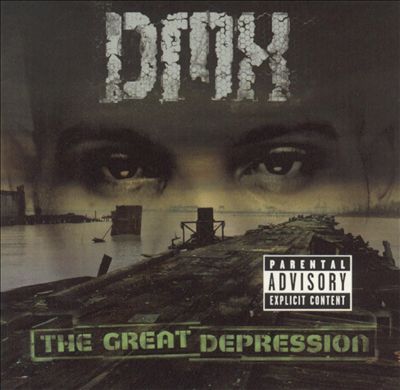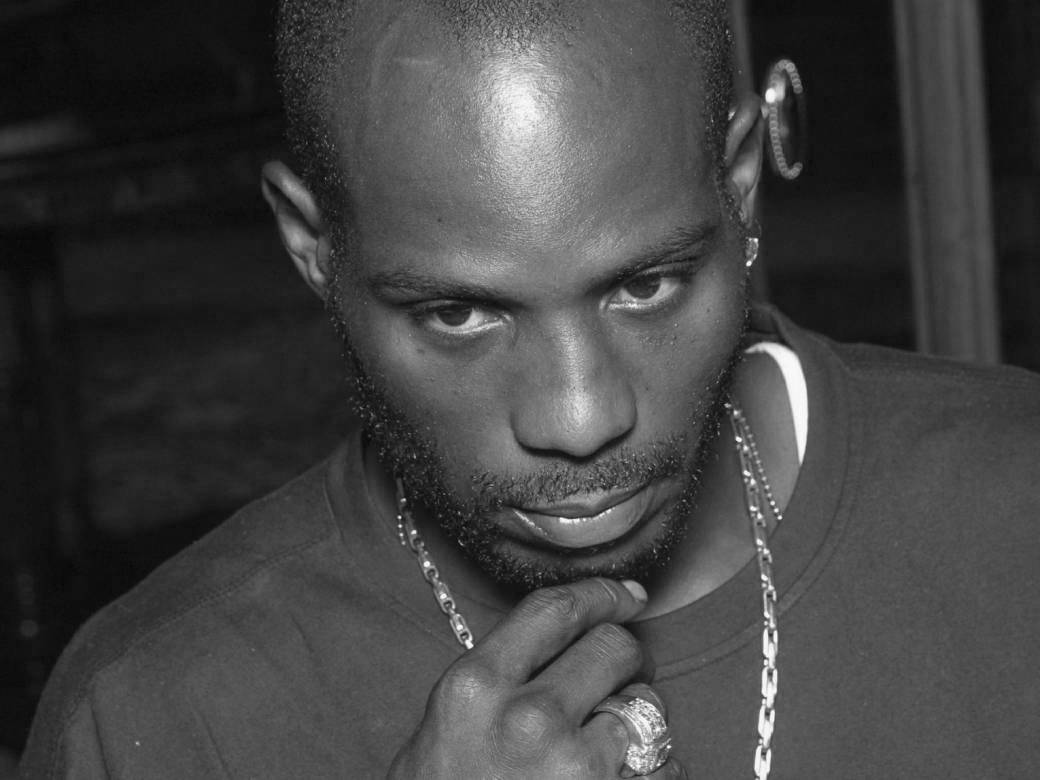DMX was born Earl Simmons on May 18, 1970 in Brooklyn, New York. His father abandoned the family when he was young and his mother worked as a nurse. DMX started rapping at age 12 and by 16 had become one of the most popular rappers in New York City.
DMX is an American rapper. He was born December 18, 1969 in Brooklyn, New York. DMX has released five studio albums and a Greatest Hits album. His fifth studio album Undisputed was released on June 12, 2012.
 DMX was 2Pac’s and the Notorious B.I.G.’s extreme rap successor. The most prominent Ruff Ryders MC was that uncommon commodity: a commercial force with plenty of creative and street cred. His meteoric rise to fame took nearly a decade to achieve, giving him plenty of time to perfect the theatrical image that made him one of rap’s most recognizable figures during his prime. From his muscular, tattooed appearance to his gruff, barking delivery, which was a great fit for his typical lyrical preoccupation with dogs, everything about DMX was unmistakably passionate. There was content behind the aesthetic as well; much of his work was linked by a concern with the divide between holy and profane.
DMX was 2Pac’s and the Notorious B.I.G.’s extreme rap successor. The most prominent Ruff Ryders MC was that uncommon commodity: a commercial force with plenty of creative and street cred. His meteoric rise to fame took nearly a decade to achieve, giving him plenty of time to perfect the theatrical image that made him one of rap’s most recognizable figures during his prime. From his muscular, tattooed appearance to his gruff, barking delivery, which was a great fit for his typical lyrical preoccupation with dogs, everything about DMX was unmistakably passionate. There was content behind the aesthetic as well; much of his work was linked by a concern with the divide between holy and profane.
He could go from spiritual sorrow to a story about street crimes in the blink of an eye, all while being the same multifaceted persona, like a hip-hop Johnny Cash. The results were so compelling that DMX became the first artist to have all five of his albums chart at number one on the Billboard 200, from It’s Dark and Hell Is Hot in 1998 to Grand Champ in 2003. The Year of the Dog begins… In 2003, his final recording with Ruff Ryders came close to extending the run to six. Despite the fact that his last studio album, Undisputed, was published in 2012, he continued to release singles until 2024. Exodus, his eighth studio album and first posthumous work, was released shortly after his sad death that year.
Earl Simmons was born on December 18, 1970, in Mount Vernon, New York. He relocated to Yonkers, a New York City suburb, with part of his family when he was a kid. He spent a lot of time in group homes and surviving on the streets via thievery, which led to numerous run-ins with the police as a result of his difficult and abusive upbringing. He found redemption in hip-hop, where he began as a DJ and human beatbox before transitioning to rapping for a larger audience, naming himself after the DMX digital drum machine (though it has also been reinterpreted to mean “Dark Man X”).
In 1991, he was featured in The Source magazine’s Unsigned Hype section after making a reputation for himself in the freestyle fight scene. The next year, Columbia subsidiary Ruffhouse signed him to a contract and released his first song, “Born Loser.” However, because to a glut of talent on the Ruffhouse roster, DMX was under-promoted, and the label decided to let him go. In 1994, he released another song, “Make a Move.”
 With an appearance on one of DJ Clue’s underground mixtapes, DMX started to revive his career. In 1997, he was signed to Def Jam for a second big label debut, and he had a memorable cameo appearance on LL Cool J’s “4, 3, 2, 1.” Guest appearances on Mase’s “24 Hours to Live” and fellow Yonkers MCs the LOX’s “Money, Power & Respect” boosted his profile even further, and he released his first Def Jam song, “Get at Me Dog,” in early 1998. The song was a huge hit on the rap and dance charts, and it helped DMX’s full-length debut, It’s Dark and Hell Is Hot, launch at number one on the Billboard 200 in May 1998. It’s Dark and Hell Is Hot was mainly produced by Swizz Beatz, who went on to have a successful career as a result of the album’s popularity. DMX’s booming, forceful presence on the mic drew him comparisons to 2Pac, and the album went on to sell over four million copies. Following that, DMX made his feature film debut in Hype Williams’ Belly, in which he co-starred.
With an appearance on one of DJ Clue’s underground mixtapes, DMX started to revive his career. In 1997, he was signed to Def Jam for a second big label debut, and he had a memorable cameo appearance on LL Cool J’s “4, 3, 2, 1.” Guest appearances on Mase’s “24 Hours to Live” and fellow Yonkers MCs the LOX’s “Money, Power & Respect” boosted his profile even further, and he released his first Def Jam song, “Get at Me Dog,” in early 1998. The song was a huge hit on the rap and dance charts, and it helped DMX’s full-length debut, It’s Dark and Hell Is Hot, launch at number one on the Billboard 200 in May 1998. It’s Dark and Hell Is Hot was mainly produced by Swizz Beatz, who went on to have a successful career as a result of the album’s popularity. DMX’s booming, forceful presence on the mic drew him comparisons to 2Pac, and the album went on to sell over four million copies. Following that, DMX made his feature film debut in Hype Williams’ Belly, in which he co-starred.
 DMX finished his second album before the end of 1998, and a looming Def Jam takeover rushed the CD onto shops that December. Flesh of My Flesh, Blood of My Blood, which featured a controversial cover picture of the rapper covered in blood, debuted at number one on the Billboard 200 and went triple platinum. The next year, DMX embarked on the smash Hard Knock Life tour with Jay-Z and the Method Man/Redman combo. The Ruff Ryders, of whom DMX was a founding member, shortly issued Ryde or Die, Vol. 1, a showcase collection. Ryde or Die, Vol. 1 premiered at number one in the spring of 1999, with contributions from DMX, Eve, the LOX, and a slew of other artists. It cemented DMX’s Midas touch.
DMX finished his second album before the end of 1998, and a looming Def Jam takeover rushed the CD onto shops that December. Flesh of My Flesh, Blood of My Blood, which featured a controversial cover picture of the rapper covered in blood, debuted at number one on the Billboard 200 and went triple platinum. The next year, DMX embarked on the smash Hard Knock Life tour with Jay-Z and the Method Man/Redman combo. The Ruff Ryders, of whom DMX was a founding member, shortly issued Ryde or Die, Vol. 1, a showcase collection. Ryde or Die, Vol. 1 premiered at number one in the spring of 1999, with contributions from DMX, Eve, the LOX, and a slew of other artists. It cemented DMX’s Midas touch.
 DMX released his third album,…And Then There Was X, in late 1999, and it earned his third consecutive number one record. It also gave him his first Top Ten success on the R&B/hip-hop chart, “Party Up,” his greatest hit song since “Get at Me Dog.” …And Then There Was X became the rapper’s best-selling album to date, selling over five million copies, thanks to the success of the follow-ups “What You Want” and “What’s My Name?” DMX returned to the big screen with a significant supporting part in Jet Li’s action film Romeo Must Die, after earning his first two Grammy nominations –…And Then There Was X was nominated for Best Rap Album and “Party Up” was nominated for Best Rap Solo Performance. Exit Wounds, a Steven Seagal action film, was his next picture, and it debuted at number one at the box office. Following the success of the film, DMX contributed the smash song “No Sunshine” to the soundtrack and secured a multi-picture contract with Warner Bros.
DMX released his third album,…And Then There Was X, in late 1999, and it earned his third consecutive number one record. It also gave him his first Top Ten success on the R&B/hip-hop chart, “Party Up,” his greatest hit song since “Get at Me Dog.” …And Then There Was X became the rapper’s best-selling album to date, selling over five million copies, thanks to the success of the follow-ups “What You Want” and “What’s My Name?” DMX returned to the big screen with a significant supporting part in Jet Li’s action film Romeo Must Die, after earning his first two Grammy nominations –…And Then There Was X was nominated for Best Rap Album and “Party Up” was nominated for Best Rap Solo Performance. Exit Wounds, a Steven Seagal action film, was his next picture, and it debuted at number one at the box office. Following the success of the film, DMX contributed the smash song “No Sunshine” to the soundtrack and secured a multi-picture contract with Warner Bros.
 DMX went to the studio to finish his fourth album, The Great Depression, which is more contemplative. It was released in the autumn of 2001, and it earned his fourth consecutive number one album. DMX released his autobiography, E.A.R.L.: The Autobiography of DMX, in late 2002, and also collaborated with Audioslave on many songs (i.e., the former Rage Against the Machine). “Here I Come,” one of their collaborations, was included on the soundtrack of DMX’s next film, Cradle 2 the Grave, a reunion with Jet Li. When it was released in March 2003, the picture premiered at number one, while the DMX-heavy soundtrack debuted in the Top Ten. Six months later, Grand Champ was released, extending the rapper’s run of chart-topping albums. The Year of the Dog begins… DMX’s last Ruff Ryders release was released three years later and hit number two. DMX’s revealing BET reality show, DMX: Soul of a Man, premiered just before the album’s release. In June 2007, a collection titled Definition of X: The Pick of the Litter was released.
DMX went to the studio to finish his fourth album, The Great Depression, which is more contemplative. It was released in the autumn of 2001, and it earned his fourth consecutive number one album. DMX released his autobiography, E.A.R.L.: The Autobiography of DMX, in late 2002, and also collaborated with Audioslave on many songs (i.e., the former Rage Against the Machine). “Here I Come,” one of their collaborations, was included on the soundtrack of DMX’s next film, Cradle 2 the Grave, a reunion with Jet Li. When it was released in March 2003, the picture premiered at number one, while the DMX-heavy soundtrack debuted in the Top Ten. Six months later, Grand Champ was released, extending the rapper’s run of chart-topping albums. The Year of the Dog begins… DMX’s last Ruff Ryders release was released three years later and hit number two. DMX’s revealing BET reality show, DMX: Soul of a Man, premiered just before the album’s release. In June 2007, a collection titled Definition of X: The Pick of the Litter was released.
 After being sidelined by legal problems in the following years, DMX returned to the studio in 2012 with Undisputed, a Top 20 smash produced by Swizz Beatz and J.R. Rotem and released on the Seven Arts label. Seven Arts also released Redemption of the Beast, his unofficial eighth album, in early 2015, reportedly without a contract or permission. As a consequence of the album, the rapper has filed a lawsuit against the record company. Dog Eats Rabbit, a collaboration between DMX and electronica musician Blackburner (Skyla Talon), was released in the spring of 2017 on the Cleopatra label. Until 2024, he only released a few singles. On April 9, 2024, at the age of 50, DMX had a heart attack and died a week later. Exodus, his first posthumous album, was revealed only a few weeks after his death. Lil Wayne, Nas, Jay-Z, Bono, and others contributed to the album, which was released in late May 2024.
After being sidelined by legal problems in the following years, DMX returned to the studio in 2012 with Undisputed, a Top 20 smash produced by Swizz Beatz and J.R. Rotem and released on the Seven Arts label. Seven Arts also released Redemption of the Beast, his unofficial eighth album, in early 2015, reportedly without a contract or permission. As a consequence of the album, the rapper has filed a lawsuit against the record company. Dog Eats Rabbit, a collaboration between DMX and electronica musician Blackburner (Skyla Talon), was released in the spring of 2017 on the Cleopatra label. Until 2024, he only released a few singles. On April 9, 2024, at the age of 50, DMX had a heart attack and died a week later. Exodus, his first posthumous album, was revealed only a few weeks after his death. Lil Wayne, Nas, Jay-Z, Bono, and others contributed to the album, which was released in late May 2024.
DMX is a rapper, singer, and actor. He has released nine studio albums and sold over thirty-two million records worldwide. His net worth is estimated to be around $30 million. Reference: dmx net worth.
Frequently Asked Questions
What was DMX biggest hit song?
DMXs biggest hit song was Slippin Into Darkness.
What songs is DMX known for?
DMX is known for his songs Get at Me Dog and Party Up (Up in Here).
How much is DMX worth right now?
DMX is worth $0.00
Related Tags
- dmx wikipedia
- dmx death
- where is dmx now
- dmx wife
- dmx kids







